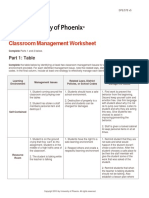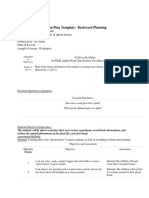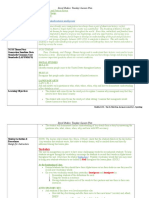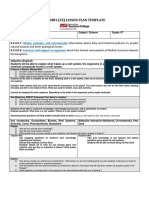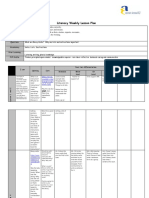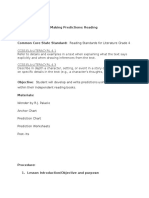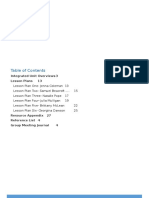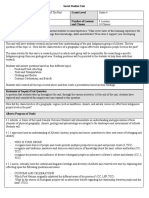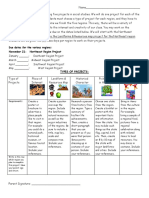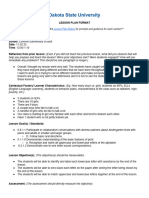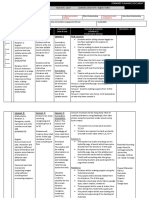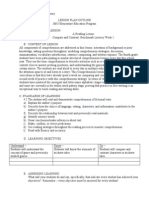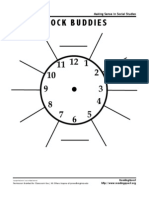West African Lesson Plan
West African Lesson Plan
Uploaded by
api-212401080Copyright:
Available Formats
West African Lesson Plan
West African Lesson Plan
Uploaded by
api-212401080Original Title
Copyright
Available Formats
Share this document
Did you find this document useful?
Is this content inappropriate?
Copyright:
Available Formats
West African Lesson Plan
West African Lesson Plan
Uploaded by
api-212401080Copyright:
Available Formats
Ashley Ostendorf Mr.
Heishman, Cub Run Elementary Week of September 1 th
LESSON PLAN OUTLINE JMU Elementary Education Program A. TITLE/TYPE OF LESSON West African Exploration: Mali, Ghana, and Songhai B. CONTEXT OF LESSON AND UNWRAPPING OF THE STANDARD This is appropriate because the fifth graders I will be teaching will already have been introduced to this topic. I discussed this lesson plan with my cooperating teacher who then suggested this topic since the students will already be going over it. This fits in with what I know about child development because most of the students are in Piagets concrete operational stage of development. This means that they can demonstrate logical and concrete reasoning. They also understand that their own thoughts are unique. This activity allows each students to apply their unique thoughts to West African exploration and cooperatively work together to review key terms and concepts. This activity also supports their need for hands-on learning! The African kingdoms of Ghana, Mali, and Songhai were centers of trade and learning. These well-developed civilizations flourished hundreds of years before the first colonists arrived in North America. Though European explorers were first drawn to West Africa in search of natural resources such as gold and spices, they eventually began to traffic in slaves. Remind students of their just-completed study of North American Native American cultures. Tell students that at about the same time in history, there were several powerful kingdoms in Africa. They have already studied Mali in second grade, so they have some background knowledge.
C. STANDARDS OF LEARNING US1.4cThe student will demonstrate knowledge of European exploration in North America and West Africa by c) identifying the location and describing the characteristics of West African societies (Ghana, Mali, and Songhai) and their interactions with traders.
D. LEARNING OBJECTIVES Understand Students will understand the location of Ghana, Mali, and Songhai in Africa. Students will understand the importance of Ghana, Mali, and Songhai. Know Students will know that they are all in the Western region of Africa, south of Sahara Desert, near the Niger River. Students will know that Ghana, Mali, and Songhai became powerful by controlling trade in West Africa. Do Students will label and locate each society on a map
Students will be able to read, discuss, and teach the class characteristics about Ghana, Mali, and Songhai
Ashley Ostendorf Mr. Heishman, Cub Run Elementary Week of September 1 th
Students will understand that West Students will know that the African empires impacted Portuguese carried goods from European trade. Europe to West African empires, trading metals, cloth, and other manufactured goods for gold.
Students will be able to analyze and discuss artifacts of cloth, metal, and gold.
E. ASSESSING LEARNING What will your students do and say, specifically, that indicate every student has achieved your objectives? Remember every objective must be assessed for every student! Objective Students will know that Ghana, Mali, and Songhai became powerful by controlling trade in West Africa. Assessment K-W-L Africa chart 2-1-1 check for understanding Data Collected I will collect the sticky notes that each child has written about what they previously know about Africa. I will collect the 2-1-1 exit cards. Students should have 2 facts they learned, a wow fact, and what they want to know more about. I will collect the students posters that will have written information as well as pictures drawn. I will collect the 2-1-1 exit cards. Students should have 2 facts they learned, a wow fact, and what they want to know more about. I will collect the flapbooks another day to make sure they have compelted and colored in the locations of each area.
Students will understand that West Mali, Ghana, and Songhai expert African empires impacted group posters European trade. 2-1-1 check for understanding
Students will understand that Ghana, Mali, and Songhai are all in the Western region of Africa, south of Sahara Desert, near the Niger River
West African society mini-map flapbook
F. MATERIALS NEEDED Poster paper Access to a computer Fill-in-the-blank notes for each student (42) Information sheets (6) Book: Anansi the Spider Pieces of gold, metal, and cloth Index cards (42) Markers for each group
Ashley Ostendorf Mr. Heishman, Cub Run Elementary Week of September 1 th
G. MISCONCEPTIONS or ALTERNATIVE CONCEPTIONS I think that my students will respond well to my lesson plan. I think that most students will not know much about West African societies. Some students may have no idea where the location of West Africa is. This must be addressed at the beginning of the lesson. I do think that students will know a little bit about Mali. Questions may arise about why this topic is important in which I would respond that just like you just previously learned about how the Europeans expored America, there were also powerful kingdoms in Africa. It is important to understand this because this eventually lead to the trafficking of slaves. Students may not understand the concept of 300-1600 A.D. I will explain that this is extremely early, before the Europeans explored America. I will need to identify what students specifically understand and what they do not. Once I know the what, I can make questions easier or harder depending on the need and ability of the classroom. H. PROCEDURE (CONTENT) I will explain that the African kingdoms of Ghana, Mali, and Songhai were centers of trade and learning. These well-developed civilizations flourished hundreds of years before the first colonists arrived in North America. Though European explorers were first drawn to West Africa in search of natural resources such as gold and spices, they eventually began to traffic in slaves. I will remind students of their just-completed study of North American Native American cultures. I will locate the part of Africa we are going to be talking about on a map I will tell students that at about the same time in history, there were several powerful kingdoms in Africa. They have already studied Mali in second grade, so they have some background knowledge. To get them in the mindset I will then read a tale from the Ashanti people of Ghana: Anansi the Spider: A Tale from the Ashanti by Gerald McDermott. I will explain that it is an example of the culture of the people of the ancient African kingdom of Ghana. While reading play African drum beats http://www.youtube.com/watch?v=iW2Ht2fuP2w Next, I will pass out sticky notes and invite students to jot down facts that they know about ancient African kingdoms. While they are writing, I will post a large blank map of Africa in front of the room. I will invite students to post their facts on the map. This will serve as a sort of "KWL" chart for the unit; students and teacher can refer to the chart throughout the unit, adding or correcting as needed. Each kingdom will also be drawn on the map as it is studied. I will make sure students have made the connection that many of the people who became slaves in North America originally came from West Africa. I will say that the people of West Africa were a diverse group with rich cultural traditions, and in this unit we will study three of the West African kingdoms. Next I will direct the students attention to the random objects in the center o their tables. They will complete this artifact exploration. I will ask them what do you notice about the objects at YOUR table. What is alike about each of these items? Why do you think they are on your
Ashley Ostendorf Mr. Heishman, Cub Run Elementary Week of September 1 th
desk? This is to show what resources are available in these kingdoms and what we got from each. Students will share what they think to the class. I will pass out the fill in blank notes. Students will partner up with the person next to them and talk out loud about what they think goes in the blanks. This is only a page long. We will go over the blanks and they will put these notes in their binder. I will split the class up into three groups- they may sit anywhere in the classroom. I will pass out a piece of chart paper to each group. Each group will be an expert group on one of the three civilizations. They will read a one page handout about each and will create a poster to teach the class about their specific society. Before students start we will as a class create a rubric of what they think needs to be on their poster- this will be written on the board for students to look at Each group will present their society and answer any questions classmates may have. This will take about 15 minutes. If we do not have time to complete the presentations we will complete them the following day. To wrap up the lesson I will ask the students to complete a 2-1-1 activity on a notecard: 2 things you learned, 1"WOW!" facts, and 1 thing you would like to know more about. If time permits I will return to the "KWL" map and any new information learned, and correct any misinformation. Finally, I will make connections to the unit coming up on explorers by reminding students of the conditions in Europe at the time. (Europeans were experiencing plagues and poverty at the time and feelings of discontent were growing as a result of the class system of the monarchies that were in existence. Europeans were becoming more and more interested in what was going on in other parts of the world, particularly Asia and Africa. They were anxious for an opportunity to improve living conditions by coming to possess some of the riches available in other parts of the world) H. DIFFERENTIATION Describe how you have planned to meet the needs of all students in your classroom with varied interest and learning readiness, English language proficiency, health, physical ability, etc. How will you extend and enrich the learning of students who finish early? How will you support the learning of children struggling with your objectives? Content If the student is not interested in the content, then I will use the music and collaborative work to gain and keep their interest. The student will be ready for this content because it has already been taught to them. Process If the student is not interested in the process of the lesson, then I will use the collaborative work and hands-on activity to gain their interests. If the study is not ready for the process of this lesson, I will give one on one assistance. Product If the student is not interested in the product of the lesson, then I will use the exit slip to at least gauge their understanding. (Although I really hope theyre interested!) If the student is not ready for the product, then I will assist them to reaching the objectives of this lesson.
Interest
Readiness
Ashley Ostendorf Mr. Heishman, Cub Run Elementary Week of September 1 th
I. WHAT COULD GO WRONG WITH THIS LESSON AND WHAT WILL YOU DO ABOUT IT? Students may not be interested in this topic which I will try and guage their attention throughout the lesson. I have catered to visual, auditory, and kinesthetic learners in this lesson. Products of posters and group presentations may not be up to par, which I have attempted to control by creating a class rubric. Students may not be focused during the fill-inthe-blank guessing discussion. This is okay because they will still be forced to hear the content in the group presentations and when I go over the fill-in-the-blank answers. We may and probably will run out of time to complete everything in this lesson planwhich is okay! This lesson may run into the following day.
You might also like
- Siop Lesson Edited For WeeblyDocument7 pagesSiop Lesson Edited For Weeblyapi-315469741No ratings yet
- Lesson Plan 2nd GradeDocument3 pagesLesson Plan 2nd Gradeapi-285101442No ratings yet
- Spe578 v5 wk5 Classroom Management Worksheet 1Document3 pagesSpe578 v5 wk5 Classroom Management Worksheet 1api-24280025667% (3)
- Science Lesson Plan 3Document8 pagesScience Lesson Plan 3api-400429333No ratings yet
- World Geography and Mississippi Studies SyllabusDocument3 pagesWorld Geography and Mississippi Studies Syllabusapi-321074185No ratings yet
- Sprout House LessonDocument4 pagesSprout House Lessonapi-404464877No ratings yet
- Geography Unit PlanDocument9 pagesGeography Unit Planapi-335727767No ratings yet
- Explorers TestDocument1 pageExplorers Testapi-212401080No ratings yet
- Landforms Lesson Plan - 1Document10 pagesLandforms Lesson Plan - 1api-212401080No ratings yet
- Lynch J 2005Document46 pagesLynch J 2005Nycto PhiliaNo ratings yet
- Group Members/Group Name: Thematic Unit Theme: Lesson 2 Title: Grade Level: Group Weebly Space AddressDocument8 pagesGroup Members/Group Name: Thematic Unit Theme: Lesson 2 Title: Grade Level: Group Weebly Space Addressapi-402126047No ratings yet
- Millicent Atkins School of Education: Common Lesson Plan TemplateDocument8 pagesMillicent Atkins School of Education: Common Lesson Plan Templateapi-346286339No ratings yet
- Week 3Document5 pagesWeek 3alexelesonNo ratings yet
- Design Your Own MapDocument6 pagesDesign Your Own MapPatrick ThorntonNo ratings yet
- Geography Unit and Marking RubricDocument9 pagesGeography Unit and Marking Rubricapi-298259310No ratings yet
- Third Grade Comprehensive Unit Plan Andrew Langhorne Stephanie Shipp Meghan Tomasi Sarah Wolfe James Madison UniversityDocument17 pagesThird Grade Comprehensive Unit Plan Andrew Langhorne Stephanie Shipp Meghan Tomasi Sarah Wolfe James Madison Universityapi-334275716No ratings yet
- Close Reading Companions Unit 9Document29 pagesClose Reading Companions Unit 9api-503734081No ratings yet
- Edso3200 MappingunitplanDocument8 pagesEdso3200 Mappingunitplanapi-252533855No ratings yet
- PBL Lesson Plan TemplateDocument2 pagesPBL Lesson Plan Templateapi-488912445No ratings yet
- Read Aloud Lesson - Ten Little LadybugsDocument4 pagesRead Aloud Lesson - Ten Little Ladybugsapi-385115220No ratings yet
- Unit Plan - Pen Pals - Social Studies-ElaDocument17 pagesUnit Plan - Pen Pals - Social Studies-Elaapi-504109603No ratings yet
- Day/Hour 1 Day/Hour 2 Day/Hour 3 Day/Hour 4 Day/Hour 5: CalendarDocument2 pagesDay/Hour 1 Day/Hour 2 Day/Hour 3 Day/Hour 4 Day/Hour 5: CalendarMorganNo ratings yet
- Geography Unit PlanDocument11 pagesGeography Unit Planapi-318180731No ratings yet
- Literacy Lesson Plans Nov 5 1Document4 pagesLiteracy Lesson Plans Nov 5 1api-302003110No ratings yet
- Unit Plan Ubd SocialDocument4 pagesUnit Plan Ubd Socialapi-478281868No ratings yet
- Interactive Notebook Ted 407Document10 pagesInteractive Notebook Ted 407api-459908593No ratings yet
- Geography Unit PlansDocument32 pagesGeography Unit Plansapi-279215532No ratings yet
- Millicent Atkins School of Education: Common Lesson Plan TemplateDocument5 pagesMillicent Atkins School of Education: Common Lesson Plan Templateapi-505035881No ratings yet
- Writing Lesson Plan April 26thDocument3 pagesWriting Lesson Plan April 26thapi-3566001480% (1)
- Making Predictions: Reading Grade: 4 Common Core State Standard: Reading Standards For Literature Grade 4Document6 pagesMaking Predictions: Reading Grade: 4 Common Core State Standard: Reading Standards For Literature Grade 4api-341005940No ratings yet
- Unit-Overview-Abor-Final-25-10-1 1Document25 pagesUnit-Overview-Abor-Final-25-10-1 1api-359895239No ratings yet
- Social Unit PlanDocument20 pagesSocial Unit Planapi-489862967No ratings yet
- Pioneer Lesson Plans and Actvities ComDocument30 pagesPioneer Lesson Plans and Actvities Comapi-287939667100% (1)
- History Unit PlanDocument9 pagesHistory Unit Planapi-377773591No ratings yet
- Social Studies Region ProjectsDocument1 pageSocial Studies Region Projectsapi-384681598No ratings yet
- Close Reading Companions Unit 5Document28 pagesClose Reading Companions Unit 5api-5037340810% (1)
- Title of Unit Grade Level 3 Curriculum Area(s) Time Frame 3-4 Weeks Developed byDocument9 pagesTitle of Unit Grade Level 3 Curriculum Area(s) Time Frame 3-4 Weeks Developed byapi-590146884No ratings yet
- Ubd 1234Document9 pagesUbd 1234api-405035385100% (1)
- Little Red Hen PDFDocument9 pagesLittle Red Hen PDFAbhishek KukretiNo ratings yet
- Lesson Plan Template: GCU College of EducationDocument15 pagesLesson Plan Template: GCU College of EducationBrittanyNo ratings yet
- Language AutobiographyDocument5 pagesLanguage Autobiographyapi-406727689No ratings yet
- Lesson Plan Template For Residency Students 12-3Document5 pagesLesson Plan Template For Residency Students 12-3Tahtiana BrooksNo ratings yet
- Reading Writing ELLDocument11 pagesReading Writing ELLjaceyNo ratings yet
- Tall TalesDocument18 pagesTall Talesapi-353798415No ratings yet
- Art Lesson PlanDocument7 pagesArt Lesson Planapi-272562683No ratings yet
- Literacy Lessons Week 7 of Unit Plan Week 2 of PlacmentDocument14 pagesLiteracy Lessons Week 7 of Unit Plan Week 2 of Placmentapi-408277860No ratings yet
- Social Studies - 5e Lesson PlanDocument5 pagesSocial Studies - 5e Lesson Planapi-635302166No ratings yet
- Small Group Lesson Plan FishingDocument4 pagesSmall Group Lesson Plan Fishingapi-594519491No ratings yet
- 5e Lesson Plan Lbs 405Document8 pages5e Lesson Plan Lbs 405api-459908593No ratings yet
- Lesson Social Studies 1st Grade 4th Semester 1Document3 pagesLesson Social Studies 1st Grade 4th Semester 1api-216889162No ratings yet
- George Washington Carver Lesson PlanDocument8 pagesGeorge Washington Carver Lesson Planapi-277952147No ratings yet
- Edtpa Lesson PlanDocument5 pagesEdtpa Lesson Planapi-279213988No ratings yet
- Mintzer Final Siop ActivitiesDocument5 pagesMintzer Final Siop Activitiesapi-251583101No ratings yet
- Forward Planning DocumentsDocument11 pagesForward Planning Documentsapi-427927675No ratings yet
- CommunitiesDocument6 pagesCommunitiesapi-192781530No ratings yet
- Teacher Work Sample Final 2Document55 pagesTeacher Work Sample Final 2api-348361949No ratings yet
- Ed 228 HRL Lesson PlanDocument4 pagesEd 228 HRL Lesson Planapi-509771251No ratings yet
- Kagan Lesson Plan 4th Grade Social StudiesDocument9 pagesKagan Lesson Plan 4th Grade Social Studiesapi-603442952No ratings yet
- Lesson Plan Ell-Added AssessmentsDocument8 pagesLesson Plan Ell-Added Assessmentsapi-307141452No ratings yet
- Lesson Plan Template: GCU College of EducationDocument6 pagesLesson Plan Template: GCU College of EducationMontell Pinkston100% (1)
- Actual UnitDocument13 pagesActual Unitapi-337403086No ratings yet
- Good Math LessonDocument2 pagesGood Math Lessonapi-283311256No ratings yet
- Unit Plan - Social StudiesDocument5 pagesUnit Plan - Social Studiesapi-361167927No ratings yet
- Hands-On Social Studies for Ontario, Grade 1: An Inquiry ApproachFrom EverandHands-On Social Studies for Ontario, Grade 1: An Inquiry ApproachNo ratings yet
- Ubd Adapations Stage 2Document2 pagesUbd Adapations Stage 2api-212401080No ratings yet
- Unit 5 Week 2 Benchmark Literacy Lesson Plans Compare and ContrastDocument9 pagesUnit 5 Week 2 Benchmark Literacy Lesson Plans Compare and Contrastapi-212401080No ratings yet
- Reading Compare and Contrast The Three Little Pigs Lesson PlanDocument5 pagesReading Compare and Contrast The Three Little Pigs Lesson Planapi-212401080No ratings yet
- Abc BrainstormDocument1 pageAbc Brainstormapi-212401080No ratings yet
- Clock BuddiesDocument1 pageClock Buddiesapi-212401080No ratings yet
- Integration of Faith and Learning Ed 302303Document3 pagesIntegration of Faith and Learning Ed 302303api-300680895No ratings yet
- Action Research FinalDocument11 pagesAction Research Finalapi-578041871No ratings yet
- PYP ClassroomDocument1 pagePYP ClassroomCristinaNo ratings yet
- Impact of Technology-5340Document41 pagesImpact of Technology-5340V Natus100% (1)
- Research TitlesDocument3 pagesResearch TitlesLuo YujinNo ratings yet
- Fba Bip Poster PresentationDocument1 pageFba Bip Poster Presentationapi-316345812No ratings yet
- STEM e CatalogDocument76 pagesSTEM e CatalogRobert Gomez Pato100% (2)
- Reconstruction Lesson 3Document5 pagesReconstruction Lesson 3api-249941070No ratings yet
- Country Case Study: Interview Report Beth Christovich EDTC 645 Dr. Wieczorek Fall 2015Document13 pagesCountry Case Study: Interview Report Beth Christovich EDTC 645 Dr. Wieczorek Fall 2015api-301048135No ratings yet
- ZARAGOSA, C - Module 2 - Prof Ed 12 - Participation & Training Assistanship - BEED 1V-A, BEED 1V-B, BEED 1V-CDocument17 pagesZARAGOSA, C - Module 2 - Prof Ed 12 - Participation & Training Assistanship - BEED 1V-A, BEED 1V-B, BEED 1V-CMarlon Rebanal0% (1)
- There Is There Are WorkshopDocument3 pagesThere Is There Are WorkshopencalambradaNo ratings yet
- Fs 1 Ep 1Document9 pagesFs 1 Ep 1Rosemarie Manang HagnaNo ratings yet
- Teaching in Diverse ClassroomDocument17 pagesTeaching in Diverse ClassroomVIBISHA MNo ratings yet
- Oral Language in The Montessori ClassroomDocument5 pagesOral Language in The Montessori ClassroomLarson ChinNo ratings yet
- Fs 6 CompilationDocument29 pagesFs 6 CompilationjanedNo ratings yet
- Diemand-Yauman Oppenheimer 2010Document5 pagesDiemand-Yauman Oppenheimer 2010Pauljohn EnriquezNo ratings yet
- Sarimanok Seal of Excellence in Classroom Management: RationaleDocument19 pagesSarimanok Seal of Excellence in Classroom Management: RationaleJhay B. MagtibayNo ratings yet
- Tesol Portfolio - Teaching Philosophy FinalDocument6 pagesTesol Portfolio - Teaching Philosophy Finalapi-361319051No ratings yet
- FS 1 Ep 1Document18 pagesFS 1 Ep 1leaNo ratings yet
- ED6 Unit 4Document9 pagesED6 Unit 4Mai Bich HanhNo ratings yet
- Phonics UDL Lesson Plan RevisedDocument6 pagesPhonics UDL Lesson Plan Revisedesmoot3100% (1)
- Google Classroom PaperDocument5 pagesGoogle Classroom Paperapi-702910967No ratings yet
- Creative Classroom WorkshopDocument43 pagesCreative Classroom WorkshopMohammadNo ratings yet
- Module 6Document14 pagesModule 6Elizabeth Gaurino0% (1)
- EDUC 5710 Unit 1 Discussion Assignment Good Example 1Document3 pagesEDUC 5710 Unit 1 Discussion Assignment Good Example 1Abed OthmanNo ratings yet
- Notes-Teacher Leader Project Culturally Responsive Teaching - Catherine Markey 2021Document18 pagesNotes-Teacher Leader Project Culturally Responsive Teaching - Catherine Markey 2021api-518265526No ratings yet
- Classroom Action Research Alternative Research Activity For TeachersDocument11 pagesClassroom Action Research Alternative Research Activity For TeachersRoisyah ZuliyantiNo ratings yet
- Winter Vacation Class 10thDocument64 pagesWinter Vacation Class 10thRoboboydabNo ratings yet


